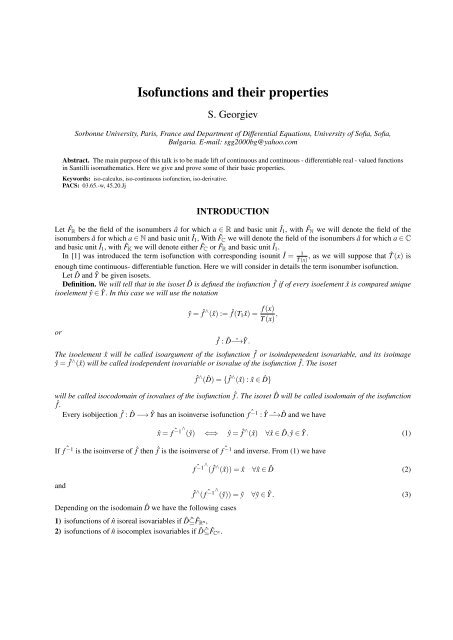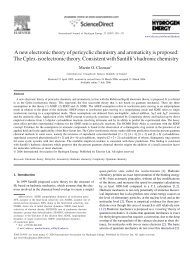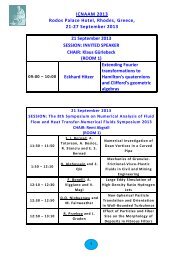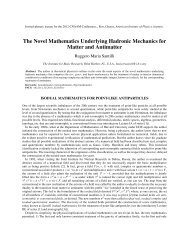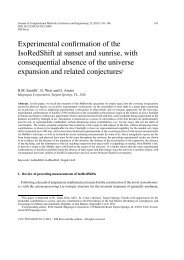Isofunctions and their properties - The RM Santilli Foundation
Isofunctions and their properties - The RM Santilli Foundation
Isofunctions and their properties - The RM Santilli Foundation
You also want an ePaper? Increase the reach of your titles
YUMPU automatically turns print PDFs into web optimized ePapers that Google loves.
<strong>Isofunctions</strong> <strong>and</strong> <strong>their</strong> <strong>properties</strong>S. GeorgievSorbonne University, Paris, France <strong>and</strong> Department of Differential Equations, University of Sofia, Sofia,Bulgaria. E-mail: sgg2000bg@yahoo.comAbstract. <strong>The</strong> main purpose of this talk is to be made lift of continuous <strong>and</strong> continuous - differentiable real - valued functionsin <strong>Santilli</strong> isomathematics. Here we give <strong>and</strong> prove some of <strong>their</strong> basic <strong>properties</strong>.Keywords: iso-calculus, iso-continuous isofunction, iso-derivative.PACS: 03.65.-w, 45.20.JjINTRODUCTIONLet ˆF R be the field of the isonumbers â for which a ∈ R <strong>and</strong> basic unit Î 1 , with ˆF N we will denote the field of theisonumbers â for which a ∈ N <strong>and</strong> basic unit Î 1 , With ˆF C we will denote the field of the isonumbers â for which a ∈ C<strong>and</strong> basic unit Î 1 , with ˆF K we will denote either ˆF C or ˆF R <strong>and</strong> basic unit Î 1 .In [1] was introduced the term isofunction with corresponding isounit Î = 1ˆT (x) , as we will suppose that ˆT (x) isenough time continuous- differentiable function. Here we will consider in details the term isonumber isofunction.Let ˆD <strong>and</strong> Ŷ be given isosets.Definition. We will tell that in the isoset ˆD is defined the isofunction ˆf if of every isoelement ˆx is compared uniqueisoelement ŷ ∈ Ŷ . In this case we will use the notationorŷ = ˆf ∧ ( ˆx) := ˆf (T 1 ˆx) = f (x)T (x) ,ˆf : ˆD −→Ŷ ˆ .<strong>The</strong> isoelement ˆx will be called isoargument of the isofunction ˆf or isoindepenedent isovariable, <strong>and</strong> its isoimageŷ = ˆf ∧ ( ˆx) will be called isodependent isovariable or isovalue of the isofunction ˆf . <strong>The</strong> isosetˆf ∧ ( ˆD) = { ˆf ∧ ( ˆx) : ˆx ∈ ˆD}will be called isocodomain of isovalues of the isofunction ˆf . <strong>The</strong> isoset ˆD will be called isodomain of the isofunctionˆf .Every isobijection ˆf : ˆD −→ Ŷ has an isoinverse isofunction f −1 ˆ : Ŷ −→ ˆ ˆD <strong>and</strong> we haveIfˆx =ˆ f −1∧ (ŷ) ⇐⇒ ŷ = ˆf ∧ ( ˆx) ∀ ˆx ∈ ˆD,ŷ ∈ Ŷ . (1)f −1 ˆ is the isoinverse of ˆf then ˆf is the isoinverse of f −1 ˆ <strong>and</strong> inverse. From (1) we have<strong>and</strong>Depending on the isodomain ˆD we have the following cases1) isofunctions of ˆn isoreal isovariables if ˆD ˆ⊆ ˆF R n,2) isofunctions of ˆn isocomplex isovariables if ˆD ˆ⊆ ˆF C n.ˆ f −1∧ ( ˆf ∧ ( ˆx)) = ˆx ∀ ˆx ∈ ˆD (2)ˆf ∧ ( ˆ f −1∧ (ŷ)) = ŷ ∀ŷ ∈ Ŷ . (3)
followsWe will writeor| ˆf ∧ ( ˆx) − â| ˆˆ0 there exists ˆδ = ˆδ(ˆε) such that from| ˆx − ˆx 0 | ˆ< ˆδ, ˆx ˆ> ˆx 0followsWe will writeor| ˆf ∧ ( ˆx) − â| ˆ ˆx 0 , ˆx ˆn −→ ˆ ˆn −→ ˆ ˆ∞ ˆx 0 , follows thatlim ˆ ˆn −→ ˆ ˆ∞ ˆf ∧ ( ˆx ˆn ) = â.IsoHeine <strong>and</strong> isoCauchy definitions for isoright isolimts are equivalent. <strong>The</strong>orem. Let ˆx 0 ∈ ˆF R . <strong>The</strong>n there existsif <strong>and</strong> only if there exist ˆf ∧ ( ˆx 0 + ˆ0), ˆf ∧ ( ˆx 0 − ˆ0) <strong>and</strong>ˆ lim ˆx−→ ˆx0 , ˆx∈ ˆD ˆf ∧ ( ˆx) = âˆf ∧ ( ˆx 0 − ˆ0) = ˆf ∧ ( ˆx 0 + ˆ0) = â.ISODIFFERENTIABLE ISOFUNCTIONSIn [1] was introduced the term isodifferentiable isofunction. <strong>The</strong> definition given there isDefinition. Let ˆx ∈ ˆD. First isoderivative of the isofunctions ˆf at the isopoint ˆx will be called( ˆf ) ⊛ := limĥ ˆ ( −→ˆ0 ˆˆf ∧ ( ˆx + ĥ) − ˆf ∧ ( ˆx)) ⋌ ĥ.In this case we will say that ˆf is isodifferentiable at the isopoint ˆx.<strong>The</strong> main connection between isoderivative <strong>and</strong> the classical one is given with( ˆf ) ⊛ = ˆf ′ − ˆf ˆ× ˆ T ′ ˆ×ˆ(Î). (4)
Below we will use the above isoform of the isoderivative.If the isofunction ˆf has isoderivative at every isopoint of ˆD we will say that the isofunction ˆf is isodifferentiable inˆD. <strong>The</strong> isoclass of such isofunctions will be denoted with FC ˆ1ˆD.In [1] was deducted the following <strong>properties</strong> of the isoderivative. Namely1. Let ˆf ,ĝ ∈ ˆ FC 1 D be isodifferentiable at the point ˆx ∈ ˆD. <strong>The</strong>n ˆf ± ĝ are isodifferentiable at the point ˆx ∈ ˆD <strong>and</strong>( ˆf ± ĝ) ⊛ = ( ˆf ) ⊛ ± (ĝ) ⊛ .2. Let ˆf ,ĝ ∈ ˆFC 1 D be isodifferentiable at the point ˆx ∈ ˆD. <strong>The</strong>n ˆf xĝ are isodifferentiable at the point ˆx ∈ ˆD <strong>and</strong>( ˆf xĝ) ⊛ = ˆf ⊛ xĝ + ˆf xĝ ⊛ + ˆf xĝ ˆ×x T ˆ ′ ˆ×ˆ(Î).3. Let ˆf ∈ FC ˆ1 D be isodifferentiable at the point ˆx ∈ ˆD. <strong>The</strong>n Î ⋌ ˆf is isodifferentiable at the point ˆx ∈ ˆD <strong>and</strong>(Î ⋌ ˆf ) ⊛ = − ˆf ′ ˆ×(Î ⋌ ˆf ) ˆ×(Î ⋌ ˆf ) − (Î ⋌ ˆf ) ˆ× T ˆ ′ ˆ×ˆ(Î).4. Let ˆf ,ĝ ∈ FC ˆ1 D be isodifferentiable at the point ˆx ∈ ˆD. <strong>The</strong>n ˆf ⋌ ĝ is isodifferentiable at the point ˆx <strong>and</strong>( ˆf ⋌ ĝ) ⊛ = ˆf ⊛ ⋌ ĝ − ˆf ˆ×ĝ ⊛ ˆ×(Î ⋌ ĝ) ˆ×(Î ⋌ ĝ)− ˆf ˆ×ĝ ˆ× ˆ T ′ ˆ×ˆ(Î) ˆ×(Î ⋌ ĝ) ˆ×(Î ⋌ ĝ).<strong>The</strong>orem. Let ˆf be isodifferentiable at the isopoint ˆx 0 ∈ ˆD. <strong>The</strong>n ˆf is isocontionuous at ˆx 0 .Definition. We will say that the isofunction ˆf has isolocal isomaximum at the isopoint ˆx 0 ∈ ˆD if there existsisoneighbourhood Û( ˆx 0 ) such that for every ˆx ∈ Û( ˆx 0 ) ˆ∩ ˆD we haveˆf ∧ ( ˆx) ˆ≤ ˆf ∧ ( ˆx 0 ).Definition. We will say that the isofunction ˆf has isolocal isominimum at the isopoint ˆx 0 ∈ ˆD if there existsisoneighbourhood Û( ˆx 0 ) such that for every ˆx ∈ Û( ˆx 0 ) ˆ∩ ˆD we haveˆf ∧ ( ˆx) ˆ≥ ˆf ∧ ( ˆx 0 ).Definition. We will say that the isofunction ˆf has isolocal isoextremum at the isopoint ˆx 0 ∈ ˆD if it has isolocalisominimum or isolocal isomaximum.<strong>The</strong>orem. Let the isofunction ˆf is isodifferentiable at the isopoint ˆx 0 ∈ ˆD <strong>and</strong> has isolocal isoextremum at it. <strong>The</strong>n( ˆf ⊛ ) ∧ ( ˆx 0 ) = ˆ0.ACKNOWLEDGEMENTSThis research has been supported in part by a grant from the R. M. <strong>Santilli</strong> <strong>Foundation</strong>.REFERENCES1. S. G. Georgiev. Introduction in the Iso-Time Scales Calculus, to appear.2. R. M. <strong>Santilli</strong>, Hadronic Mathematics, Mechanics <strong>and</strong> Chemistry, Volume I: Limitations of EinsteinâĂŹs Special <strong>and</strong>General Relativities, Quantum Mechanics <strong>and</strong> Quantum Chemistry, available as a free download in pdf from the websitehttp://www.i-b-r.org/Hadronic-Mechanics.htm3. R. M. <strong>Santilli</strong>, Hadronic Mathematics, Mechanics <strong>and</strong> Chemistry, Volume II: Isodual <strong>The</strong>ory of Antimatter, Antigravity <strong>and</strong>Spacetime Machines, available as a free download in pdf from the website http://www.i-b-r.org/Hadronic-Mechanics.htm4. R. M. <strong>Santilli</strong>, Hadronic Mathematics, Mechanics <strong>and</strong> Chemistry, Volume III: Iso-, Geno-, Hyper-Formulations for Matter<strong>and</strong> <strong>The</strong>ir Isoduals for Antimatter, available as a free download in pdf from the website http://www.i-b-r.org/Hadronic-Mechanics.htm5. R. M. <strong>Santilli</strong>, Hadronic Mathematics, Mechanics <strong>and</strong> Chemistry, Volume IV: Experimental Verifications, <strong>The</strong>oretical Advances<strong>and</strong> Industrial Applications in Particle Physics, Nuclear Physics <strong>and</strong> Astrophysics, available as a free download in pdf from thewebsite http://www.i-b-r.org/Hadronic-Mechanics.htm


